Commercial Salmon Fisheries
Southeast Alaska & Yakutat Research: Chilkoot Lake Salmon Research
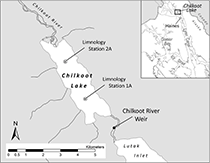
Figure 1. — Click for more Info
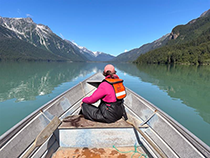
Figure 2. — Click for more Info
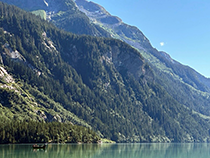
Figure 3. — Click for more Info
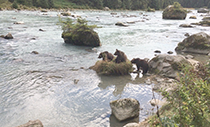
Figure 4. — Click for more Info
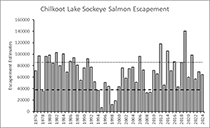
Figure 5. — Click for more Info

Figure 6. — Click for more Info
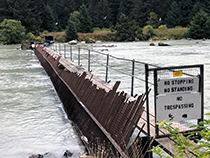
Figure 7. — Click for more Info
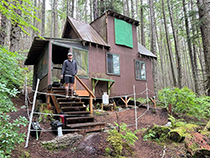
Figure 8. — Click for more Info

Figure 9. — Click for more Info
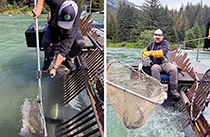
Figure 10. — Click for more Info
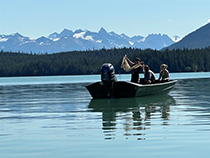
Figure 11. — Click for more Info
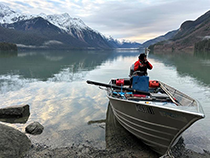
Figure 12. — Click for more Info
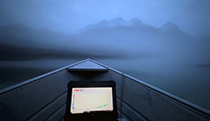
Figure 13. — Click for more Info
Introduction
The Chilkoot River, located near the town of Haines, is one of the most productive sockeye salmon systems in Southeast Alaska, and supports large runs of pink and coho salmon. Chilkoot River sockeye salmon have been an important contributor to northern Southeast Alaska commercial fisheries for over a century and an important subsistence resource for Alaska Natives. ADF&G has monitored adult salmon escapements through a weir below Chilkoot Lake annually since 1976. The current sustainable escapement goal of 38,000–86,000 sockeye salmon was established in 2009 based on a stock-recruit analysis. In addition to salmon counts, biological data have been collected annually at the weir to estimate age, size, and sex composition of sockeye salmon escapements. Basic information about lake productivity and rearing sockeye salmon fry populations have also been collected through limnological and hydroacoustic sampling conducted most years since 1987 to assess potential sockeye salmon production from the lake.
Location
Chilkoot Lake is located at the head of Lutak Inlet, approximately 16 kilometers northeast of the city of Haines, Alaska (Figure 1) and is part of Chilkoot State Park. It is glacially turbid, has a surface area of 7.2 km (1,734 acres) and a maximum depth of 89 meters (Figures 2 and 3). The Chilkoot River originates at glacier terminuses east of the Takshanuk Mountains and west of the Ferebee Glacier. The glacial river flows approximately 26 kilometers southeast into Chilkoot Lake, then flows approximately 2 kilometers into Lutak Inlet (Figure 4). Early-run sockeye salmon spawn in small lake and river tributaries and late-run fish spawn in the main channel of the Chilkoot River and along lake beaches where upwelling water occurs. Chilkoot Lake is located within the northern temperate rainforest that dominates the Pacific Northwest coast of North America.
Adult salmon escapement
A weir has been operated annually on the Chilkoot River since 1976 to identify and enumerate returning adult salmon and determine if escapement goals are met. As mentioned, large runs of sockeye, pink, and coho salmon pass through the weir, but chum salmon are also counted in smaller numbers, and a few Chinook salmon pass through the weir each year. Though it supports all these runs, the weir is in place specifically to cover the timing of the sockeye salmon run. This usually coincides with the pink salmon run, and acts as an indicator for coho salmon run strength. Historically, sockeye salmon returns to Chilkoot Lake have averaged 70,041 salmon (range: 7,177–140,378). Sockeye salmon have exceeded the lower bound of the escapement goal 85% of the time since 1976 with one period of low counts from 1994–1999 (Figure 5).
The Chilkoot Lake weir is a 110-meter-long permanent steel structure anchored with 20-centimeter steel pilings driven approximately 7 meters into the bottom of the Chilkoot River channel (Figures 6 and 7). The weir is 1 km from the saltwater and approximately halfway between Chilkoot Lake and Lutak Inlet. Generally, the weir is installed from early June until mid-September, and technicians remain on site for the entirety of the season. Housing on site consists of a single cabin that looks down on the weir (Figure 8) so technicians can monitor the weir and ensure the structure remains uncompromised. Of the 3-person team, 2 members are generally on scene to work the weir which allows for a rotating schedule with days off. The crew's dedication is the foundation of successfully monitoring Chilkoot Lake sockeye salmon, which in turn helps influence management of the District 15 commercial drift gillnet, subsistence, and sport fisheries.
The Chilkoot Lake weir is fully functional from early June through early September to monitor the majority of the sockeye salmon run. To minimize handling, most fish are not captured but simply counted by species as they pass through the weir (Figure 9). A subset of the fish are caught with a dip net from the upstream side of the weir as they pass through the counting station and are then examined to determine sex, measured for length, and sampled for scales to determine age composition (Figure 10).
Limnology and Hydroacoustic Fry Surveys
Once a month, crew take the jet boat out to 2 anchored buoy locations to collect basic limnological data including zooplankton samples and light and temperature readings (Figure 11). This historical dataset goes back to 1987 and provides a monthly snapshot of temperature and light profiles as well as zooplankton presence and abundance, with samples processed by the Kodiak Island Limnology Laboratory. These details help track the basic environmental conditions of Chilkoot Lake over time and can act as an indicator for salmon health.
In late October–early November, a hydroacoustic survey is conducted to estimate the number of sockeye salmon fry rearing in the lake (Figures 12 and 13). Juvenile sockeye salmon rearing in lakes typically undergo what is known as a diel vertical migration, where they move shallower in the evening and deeper during the daytime. We conduct the survey at night when the juvenile sockeye salmon are generally in the upper 20–30 meters of the water column by towing a sonar system across 12 individual transects over the length of the lake. The estimates of juvenile abundance allow ADF&G scientists to compare relative reproductive success of spawning escapements through time.
Commercial harvest, total run, and harvest rates
The number of Chilkoot Lake sockeye salmon harvested in commercial fisheries is estimated using genetic stock identification (GSI) analysis. Sockeye salmon tissue and scale samples are collected from District 15 commercial drift gillnet fishery landings by ADF&G Port Sampling Program staff at fish processing facilities in Haines, Juneau, and Petersburg. Sampling is stratified by statistical week, and sampling efforts cover the first 10 weeks of the fishery when approximately 94% of sockeye salmon harvest occurs. Samples are processed inseason with results quickly available thanks to dedicated staff at the ADF&G Gene Conservation Lab, allowing for the weekly calculation of Chilkoot sockeye salmon harvest. The total run is the total Chilkoot Lake harvest in commercial, sport, and subsistence fisheries plus the escapement count at the weir. Sockeye salmon harvest rates vary from year to year and by week of harvest.
Selected Publications
- Operational Plan: Stock Assessment Studies of Chilkoot Lake Sockeye Salmon, 2023–2025 (PDF 3,731 kB)
- Operational Plan: Stock Assessment Studies of Chilkoot Lake Sockeye Salmon, 2020–2022 (PDF 2,237 kB)
- Stock Assessment Study of Chilkoot Lake Sockeye Salmon, 2020–2021 (PDF 2,363 kB)
- Stock Assessment Study of Chilkoot Lake Sockeye Salmon, 2016–2019 (PDF 2,181 kB)
- Stock Assessment Study of Chilkoot Lake Sockeye Salmon, 2013–2015 (PDF 740 kB)
- Escapement and Harvest of Chilkoot River Sockeye Salmon, 2007–2012 (PDF 2,088 kB)
- Escapement and Harvest of Chilkoot River Sockeye Salmon, 2004–2006 (PDF 1,740 kB)
- Sockeye Salmon Stock Status and Escapement Goals for Chilkoot Lake in Southeast Alaska (PDF 1,811 kB)
- Summary of Limnology and Fisheries Investigation of Chilkoot Lake, 2001–2004 (PDF 2,339 kB)
